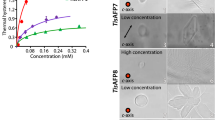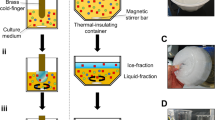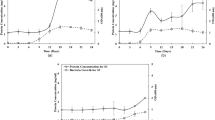Abstract
Antifreeze proteins (AFPs), which are present in the bodily fluids of organisms inhabiting cold environments, function as inhibitors of ice growth by binding to certain planes of ice crystals. However, the exact mechanism of ice growth inhibition is still poorly understood as it is exceedingly difficult to experimentally analyze the molecular-scale growth kinetics of ice crystals at the planes to which the proteins bind. This review paper focuses on computer simulation studies on the mechanism of ice growth inhibition by AFPs. Recent molecular dynamics simulations of a growing ice–water interface to which protein is bound have indicated that, when the protein is stably bound to the interface, the growth rate of ice surrounding the protein decreases drastically, owing to depression of the ice melting point through the Gibbs–Thomson effect. The observed decrease in growth rate is expected to correspond to ice growth inhibition in real-world systems. In addition to presenting published simulation studies on the mechanism of ice growth inhibition by AFPs, this review also outlines the direction of future simulation studies in this field.
Similar content being viewed by others
Log in or create a free account to read this content
Gain free access to this article, as well as selected content from this journal and more on nature.com
or
References
Yeh, Y. & Feeney, R. E. Antifreeze proteins: structures and mechanisms of function. Chem. Rev. 96, 601–618 (1996).
DeVries, A. L., Komatsu, S. K. & Feeney, R. E. Chemical and physical properties of freezing-point depressing glycoproteins from antarctic fishes. J. Biol. Chem. 245, 2901–2908 (1970).
Davies, P. L., Hew, C. L. & Fletcher, G. L. Fish antifreeze proteins: physiology and evolutionary biology. Can. J. Zool. 66, 2611–2617 (1988).
Marshall, C. B., Fletcher, G. L. & Davies, P. L. Hyperactive antifreeze protein in a fish. Nature 429, 153 (2004).
Hew, C. L., Kao, M. H., So, Y.-P. & Lim., K.-P. Presence of cystine-containing antifreeze proteins in the spruce budworm, Choristoneura fumirana. Can. J. Zool. 61, 2324–2328 (1983).
Schneppenheim, R. & Theede, H. Isolation and characterization of freezing-point depressing peptides from larvae of Tenebrio molitor. Comp. Biochem. Phys. B. Biochem. Mol. Biol. 67, 561–568 (1980).
Duman, J. G., Bennett, V., Sformo, T., Hochstrasser, R. & Barnes, B. M. Antifreeze proteins in alaskan insects and spiders. J. Insect Physiol. 50, 259–266 (2004).
Gilbert, J. A., Christine, P. J., Dodd, E. R. & Layborn-Parry, J. Demonstration of Antifreeze Protein Activity in Antarctic Lake Bacteria. Microbiology 150, 171–180 (2004).
Muryoi, N., Sato, M., Kaneko, S., Kawahara, H., Obata, H., Yaish, M. W. F., Griffith, M. & Glick, B. R. Cloning and expression of afpA, a gene encoding an antifreeze protein from the arctic plant growth-promoting rhizobacterium Pseudomonas Putida GR12-2. J. Bacteriol. 186, 5661–5671 (2004).
Atıcı, Ö. & Nalbantoğlu, B. Antifreeze proteins in higher plants. Phytochemistry 64, 1187–1196 (2003).
Griffith, M. & Yaish, M. W. F. Antifreeze proteins in overwintering plants: a tale of two activities. Trends Plant Sci. 9, 399–405 (2004).
Zachariassen, K. E. & Kristiansen, E. Ice nucleation and antinucleation in nature. Cryobiology 41, 257–279 (2000).
Lee, R. E., Warren, G. J. & Gusta, L. V. in Biological Ice Nucleation and Its Applications, (APS Press: St Paul, 1997).
Grandum, S., Yabe, A., Tanaka, M., Takemura, F. & Nakamori, K. Characteristics of ice slurry containing antifreeze protein for ice storage applications. J. Thermophys. Heat Transfer 11, 461–466 (1997).
Mann, S. Molecular recognition in biomineralization. Nature 332, 119–124 (1998).
Sangwal, K. in Additives and Crystallization Processes, John Wiley & Sons Ltd, Chichester, 2007).
Davies, P. L. & Hew, C. L. Biochemisty of fish antifreeze proteins. FASEB J. 4, 2460–2468 (1990).
Hew, C. L. & Yang, D. S. C. Protein interaction with ice. Eur. J. Biochem. 203, 33–42 (1992).
Barrett, J. Thermal hysteresis proteins. Int. J. Biochem. Cell Biol. 33, 105–117 (2001).
Davies, P. L., Baardsnes, J., Kuiper, M. J. & Walker, V. K. Structure and function of antifreeze proteins. Phil. Trans. R. Soc. Lond. B. 357, 927–935 (2002).
Kristiansen, E. & Zachariassen, K. E. The mechanism by which fish antifreeze proteins cause thermal hysteresis. Cryobiology 51, 262–280 (2005).
Raymond, J. A. & DeVries, A. L. Adsorption inhibition as a mechanism of freeze resistance in polar fishes. Proc. Natl. Acad. Sci. USA 74, 2589–2593 (1977).
Knight, C. A. & DeVries, A. L. Melting inhibition and superheating of ice by antifreeze glycopeptide. Science 245, 505–507 (1989).
Kuroda, T. in Proc. 4th Topical Conference on Crystal Growth Mechanisms 1–4 (1991).
Sander, L. M. & Tkachenko, A. V. Kinetic pinning and biological antifreezes. Phys. Rev. Lett. 93, 128102 (2004).
Knight, C. A., Cheng, C. C. & DeVries, A. L. Adsorption of α-helical antifreeze peptides on specific ice crystal surface planes. Biophys. J. 59, 409–418 (1991).
Pertaya, N., Marshall, C. B., Celik, Y., Davies, P. L. & Braslavsky, I. Direct visualization of spruce budworm antifreeze protein interacting with ice crystals: basal plane affinity confers hyperactivity. Biophys. J. 95, 333–341 (2008).
Allen, M. P. & Tildesley, D. J. in Computer Simulation of Liquid, (Oxford University Press: Oxford, 1987).
Frenkel, D. & Smit, B. in Understanding Molecular Simulation, (Academic Press: San Diego, 1996).
Wen, D. & Laursen, R. A. A. Model for binding of a antifreeze polypeptide to ice. Biophys. J. 63, 1659–1662 (1992).
Madura, J. D., Wierzbicki, A., Harrington, J. P., Maughon, R. H., Raymond, J. A. & Sikes, C. S. Interactions of the D and L forms of winter flounder antifreeze peptide with the {201} planes of ice. J. Am. Chem. Soc. 116, 417–418 (1994).
Chen, A. & Merz, K. M. Ice binding mechanism of winter flounder antifreeze proteins. Biophys. J. 73, 2851–2873 (1997).
Dalal, P. & Sönnichsen, F. D. Source of the ice-binding specificity of antifreeze protein type I. J. Chem. Inf. Comput. Sci. 40, 1276–1284 (2000).
Jorov, A., Zhorov, B. S. & Yang, D. S. C. Theoretical study of interaction of winter flounder antifreeze protein with ice. Protein Sci. 13, 1524–1537 (2004).
Wierzbicki, A., Taylor, M. S., Knight, C. A., Madura, J. A., Harrington, J. P. & Sikes, C. S. Analysis of shorthorn sculpin antifreeze protein stereospecific binding to (2 −1 0) faces of ice. Biophys. J. 71, 8–18 (1996).
Madura, J. D., Taylor, M. S., Wierzbicki, A., Harrington, J. P. & Sönnichsen, F. D. The dynamics and binding of a type III antifreeze protein in water and on ice. Theochem. 388, 65–77 (1996).
Jia, Z., DeLuca, C. I., Chao, H. & Davies, P. L. Structural basis for the binding of a globular antifreeze protein to ice. Nature 384, 285–288 (1996).
Nada, H. & Furukawa, Y. Growth inhibition mechanism of an ice–water interface by a mutant of winter flounder antifreeze protein: a molecular dynamics study. J. Phys. Chem. B 112, 7111–7119 (2008).
Nada, H. & Furukawa, Y. Growth inhibition at the ice prismatic plane induced by a spruce budworm antifreeze protein: a molecular dynamics simulation study. Phys. Chem. Chem. Phys. 13, 19936–19942 (2011).
Graether, S. P. in Biochemistry and Function of Antifreeze Proteins ed. S. P. Graether Ch. 6, 141–189 (Nova Science Publishers, Inc.: New York, 2010).
Yang, D. S. C., Sax, M., Chakrabartty, A. & Hew, C. L. Crystal structure of an antifreeze polypeptide and its mechanistic implications. Nature 333, 232–237 (1988).
Sicheri, F. & Yang, D. S. C. Ice binging structure and mechanism of an antifreeze protein from winter flounder. Nature 374, 427–431 (1995).
Kwan, A. H. Y., Fairley, K., Anderberg, P. I., Liew, C. W., Harding, M. M. & Mackay, J. P. Solution structure of a recombinant type I sculpin antifreeze protein. Biochemistry 44, 1980–1988 (2005).
Slaughter, D., Fletcher, G. L., Ananthanarayanan, V. S. & Hew, C. L. Antifreeze proteins from the sea raven, Hemitripterus Americanus. future evidence for diversity among fish peptide antifreezes. J. Biol. Chem. 256, 2022–2026 (1981).
Gronward, W., Loewen, M. C., Lix, B., Daugulis, A. J., Sönnichsen, F. D., Davies, P. L. & Sykes, B. D. The solution structure of type II antifreeze protein reveals a new member of the lectin family. Biochemistry 37, 4712–4721 (1998).
Sönnichsen, F. D., Sykes, B. D., Chao, H. & Davies, P. L. The nonhelical structure of antifreeze protein type III. Science 259, 1154–1157 (1993).
Deng, G., Andrews, D. W. & Laursen, R. A. Amino acid sequence of a new type of antifreeze protein, from the longhorn sculpin Myoxyxephalus Octodecimspinosis. FEBS Lett. 402, 17–20 (1997).
Graether, S. P., Kuiper, M. J., Gange, S. M., Walker, V. K., Jia, Z., Sykes, B. D. & Davies, P. L. β-helix structure and ice-binding properties of a hyperactive antifreeze protein from an insect. Nature 406, 325–328 (2000).
Liou, Y., Tocilj, A., Davies, P. L. & Jia, Z. Mimicry of ice structure by surface hydroxyls and water of a β-helix antifreeze protein. Nature 406, 322–324 (2000).
Schrag, J. D., O' Gray, S. M. & DeVries, A. L. Relationship of amino acid composition and molecular weight of antifreeze glycopeptides to non-colligative freezing point depression. Biochim. Biophys. Acta. 717, 322 (1982).
Uda, Y., Zepeda, S., Kaneko, F., Matsuura, Y. & Furukawa, Y. Adsorption-induced conformational changes of antifreeze glycoproteins at the ice/water interface. J. Phys. Chem. B 111, 14355–14361 (2007).
Madura, J. D., Baran, K. & Wierzbicki, A. Molecular recognition and binding of thermal hysteresis proteins to ice. J. Mo. Recognit. 13, 101–113 (2000).
Hobbs, P. V. in Ice Phys., (Clarendon Press, 1967).
Scotter, A. J., Marshall, C. B., Graham, L. A., Gilbert, J. A., Garnham, C. P. & Davies, P. L. The basis for hyperactivity of antifreeze proteins. Cryobiology 53, 229–239 (2006).
Zang, W. & Laursen, R. A. Structure-function relationships in a type I antifreeze polypeptide. The role of threonine methyl and hydroxyl groups in antifreeze activity. J. Biol. Chem. 52, 34806 (1998).
Baardsnes, J., Kondejewski, L. H., Hodge, R. S., Chao, H., Kay, C. & Davies, P. L. New ice-binding face for type I antifreeze protein. FEBS Lett. 463, 87 (1999).
Tyshenko, M. G., Doucet, D., Davies, P. L. & Walker, V. K. The antifreeze potential of the spruce budworm thermal hysteresis protein. Nat. Biotech. 15, 887–890 (1997).
Zepeda, S., Yokoyama, E., Uda, Y., Katagiri, C. & Furukawa, Y. In situ observation of antifreeze glycorotein kinetics at the ice interface reveals atwo-step reversible adsorption mechanism. Cryst. Growth Des. 8, 3666–3672 (2008).
Liu, K., Jia, Z., Chen, G., Tung, C. & Liu, R. Systematic size study of an insect antifreeze protein and its interaction with ice. Biophys. J. 88, 953–958 (2005).
Karim, O. A. & Haymet, A. D. J. The ice/water interface: a molecular dynamics simulation study. J. Chem. Phys. 89, 6889–6896 (1988).
Beaglehole, D. & Wilson, P. W. Thickness and anisotropy of the ice-water interface. J. Phys. Chem. 97, 11053–11058 (1993).
Nada, H. & Furukawa, Y. Anisotropic properties of ice/water interface: A molecular dynamics study. Jpn. J. Appl. Phys. 34, 583–588 (1995).
Nada, H. & Furukawa, Y. Anisotropy in growth kinetics at interfaces between proton-disordered hexagonal ice and water: a molecular dynamics study using the six-site model of H2O. J. Cryst. Growth 283, 242–256 (2005).
Wierzbicki, A., Dalal, P., Cheatham, T. E., Knickelbein, J. E., Haymet, A. D. J. & Madura, J. D. Antifreeze proteins at the ice/water interface: three calculated discriminating properties for orientation of type I proteins. Biophys. J. 93, 1442–1451 (2007).
McDonald, S. M., White, A. & Clancy, P. Binding of an antifreeze polypeptide to an ice/water interface via computer simulation. AIChE. J. 41, 959–973 (1995).
Dalal, P., Knickelbein, J., Haymet, A. D. J., Sönnichsen, F. D. & Madura, F. D. Hydrogen bond analysis of type 1 antifreeze protein in water and the ice/water interface. Phys. Chem .Comm. 7, 1–5 (2001).
Nada, H. & van der Eerden, J. P. An intermolecular potential model for the simulation of ice and water near the melting point: a six-site model of H2O. J. Chem. Phys. 118, 7401–7413 (2003).
Berendsen, H. J. C., Grigera, J. R. & Straatsma, T. P. The missing term in effective pair potentials. J. Phys. Chem. 91, 6269–6271 (1987).
Jorgensen, W. L., Chandrasekhar, J., Madura, J. D., Impey, R. W. & Klein, M. L. Comparison of simple potential functions for simulating liquid water. J. Chem. Phys. 79, 926–935 (1983).
Mahoney, M. W. & Jorgensen, W. L. A. Five-site model for liquid water and the reproduction of density anomaly by rigid, nonpolarizable potential functions. J. Chem. Phys. 112, 8910–8922 (2000).
Nada, H., van der Eerden, J. P. & Furukawa, Y. A. Clear observation of crystal growth of ice from water in a molecular dynamics simulation with a six-site potential model of H2O. J. Cryst. Growth 266, 297–302 (2004).
Carignano, M. A., Shepson, P. B. & Szleifer, I. Molecular dynamics simulations of ice growth from supercooled water. Mol. Phys. 103, 2957–2967 (2005).
Nada, H. Analysis of ice crystal growth shape under high pressure using molecular dynamics simulation. Cryst. Growth Des. 11, 3130–3136 (2011).
Haymet, A. D. J., Ward, L. G., Harding, M. M. & Knight, C. A. Valine substituted winter flounder ‘antifreeze’: preservation of ice growth hysteresis. FEBS Lett. 430, 301–306 (1998).
Liepinsh, E., Otting, G., Harding, M. M., Ward, L. G., Mackay, J. P. & Haymet, A. D. J. Solution structure of a hydrophobic analogue of the winter flounder antifreeze protein. Eur. J. Biochem. 269, 1259–1266 (2002).
Haymet, A. D. J., Ward, L. G. & Harding, M. M. Winter flounder ‘Antifreeze’ proteins: synthesis and ice growth inhibition of analogues that probe the relative importance of hydrophobic and hydrogen-binding interactions. J. Am. Chem. Soc. 121, 941–948 (1999).
Neria, E., Fischer, S. & Karplus, M. Simulation of activation free energies in molecular systems. J. Chem. Phys. 105, 1902–1921 (1996).
Nada, H. & Furukawa, Y. in Physics and Chemistry of Ice 2010 (eds. Y. Furukawa, G. Sazaki, T. Uchida, N. Watanabe 429–436 (Hokkaido Univ. Press: Sapporo, 2011).
Garnham, C. P., Campbell, R. L. & Davies, P. L. Anchored clathrate waters bind antifreeze proteins to ice. Proc. Natl. Acad. Sci. USA 108, 7363–7367 (2011).
Nutt, D. R. & Smith, J. C. Dual function of the hydration layer around an antifreeze protein revealed by atomistic molecular dynamics simulations. J. Am. Chem. Soc. 130, 13066–13073 (2008).
Nada, H., Zepeda, S., Miura, H. & Furukawa, Y. Significant alternations in anisotropic ice growth rate induced by the ice nucleation-active bacteria Xanthomonas Campestris. Chem. Phys. Lett. 498, 101–106 (2010).
Nomura, K. & Furukawa, Y. in J. Jpn. Association for Crystal Growth (in Japanese) 31, 177 (2004).
Acknowledgements
This work was supported by a Grant-in-Aid for Scientific Research (C) (No. 21540423) from the Japan Society for the Promotion of Science. Parts of this work, an MD simulation for sbwAFP, were also supported by a Grant-in-Aid for Scientific Research (No. 22107004) on Innovative Areas of ‘Fusion Materials’ (Area no. 2206) from the Ministry of Education, Culture, Sports, Science and Technology (MEXT).
Author information
Authors and Affiliations
Corresponding author
Rights and permissions
About this article
Cite this article
Nada, H., Furukawa, Y. Antifreeze proteins: computer simulation studies on the mechanism of ice growth inhibition. Polym J 44, 690–698 (2012). https://doi.org/10.1038/pj.2012.13
Received:
Revised:
Accepted:
Published:
Issue date:
DOI: https://doi.org/10.1038/pj.2012.13
Keywords
This article is cited by
-
Psychrophiles to control ice-water phase changes in frost-susceptible soils
Scientific Reports (2024)
-
Structural diversity of marine anti-freezing proteins, properties and potential applications: a review
Bioresources and Bioprocessing (2022)
-
Janus regulation of ice growth by hyperbranched polyglycerols generating dynamic hydrogen bonding
Nature Communications (2022)
-
Balance between hydration enthalpy and entropy is important for ice binding surfaces in Antifreeze Proteins
Scientific Reports (2017)
-
Importance of water in the control of calcite crystal growth by organic molecules
Polymer Journal (2015)



